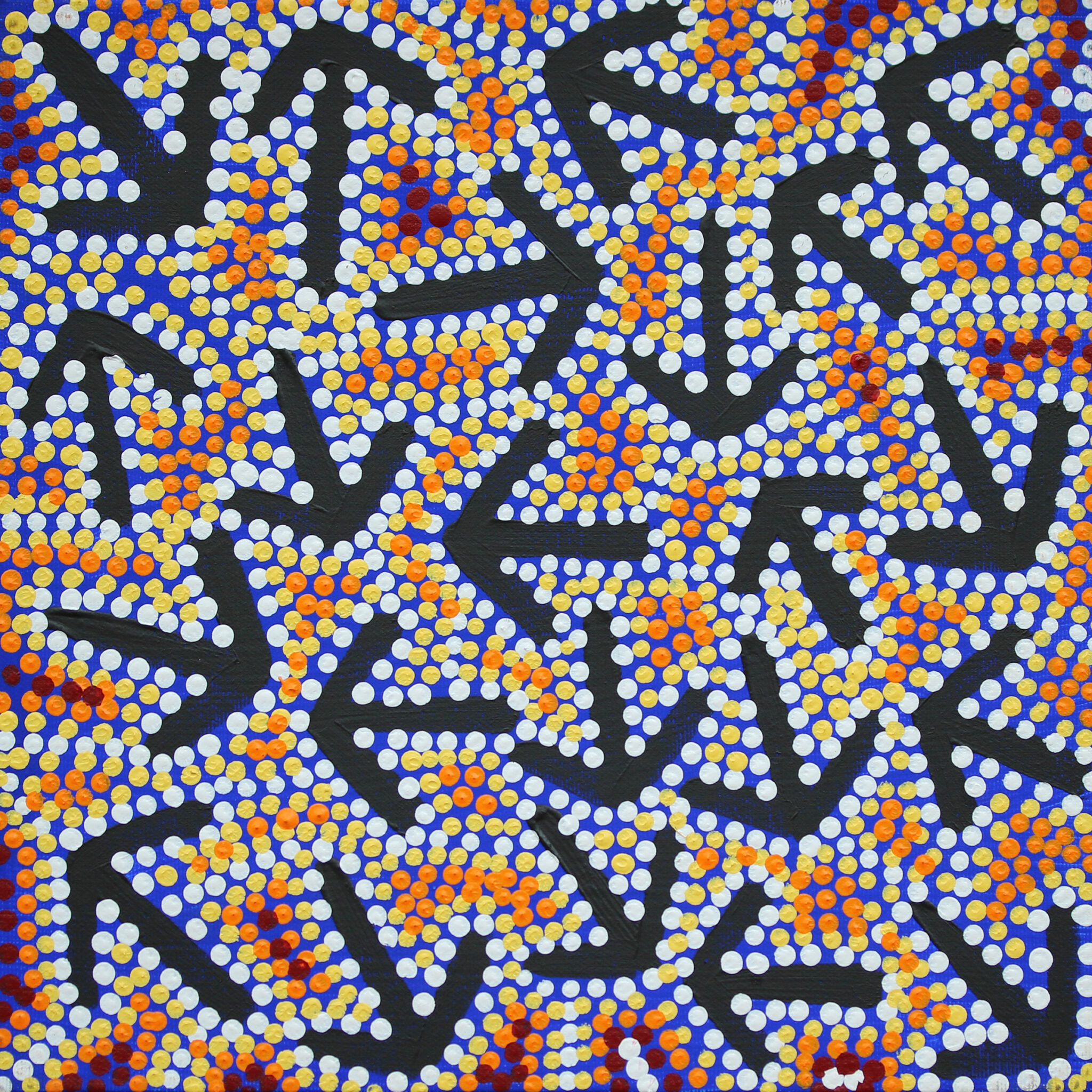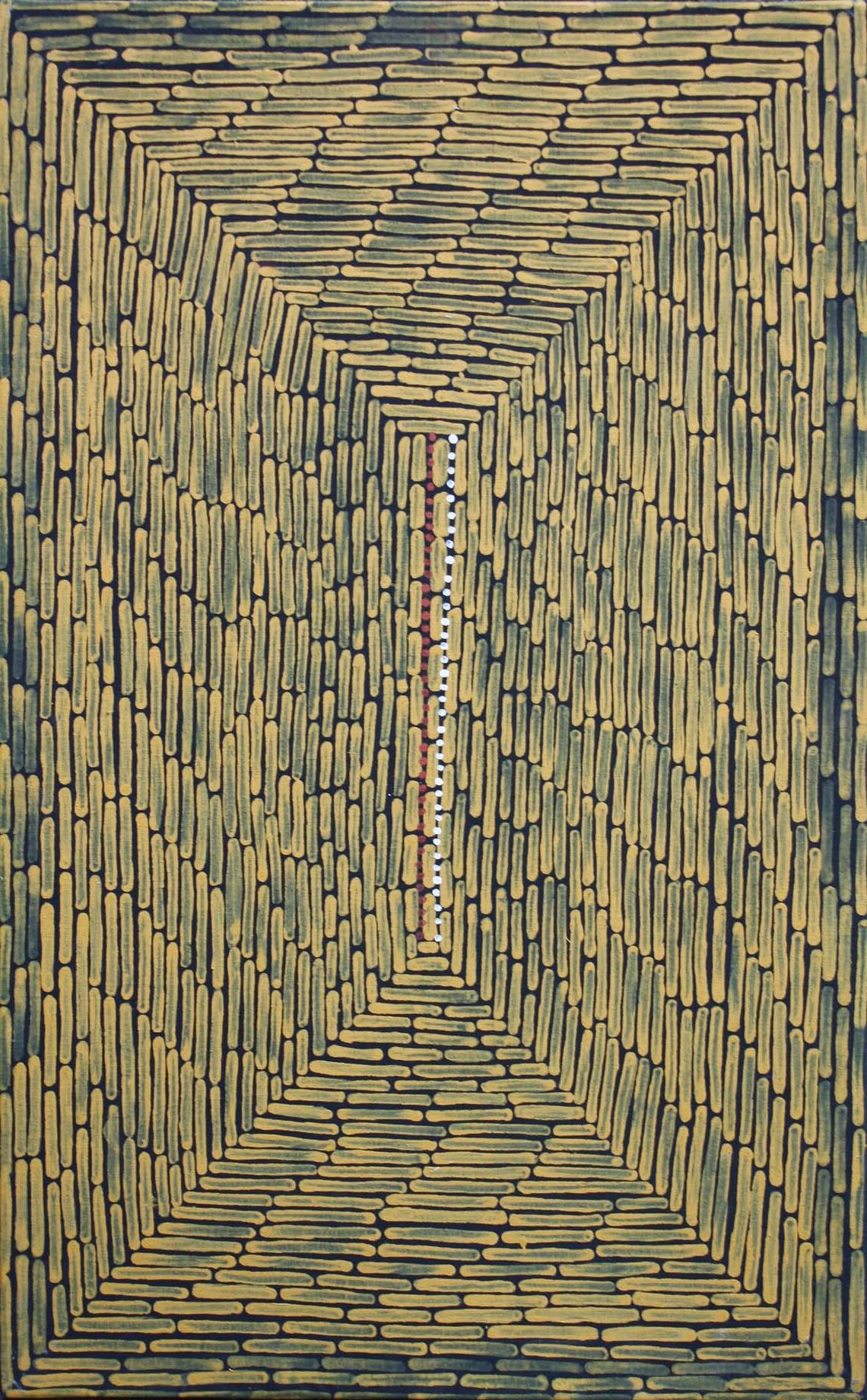Kaapa Mbitjana Tjampitjinpa
Details
Biography
These notes were provided by Owen & Gwen Daniels of Taranna, Tasmania. Kaapa was a lovable rascal, full of humour. We, Owen and I, knew him better than most Europeans, maybe we were more tolerant of his foibles. We were there (in Papunya) from late 1974. This photo was taken in our garden where he did quite a few paintings. He found it difficult to paint in his camp as he had a heap of kids to his three wives who were sisters. At that time I ran the Women’s Centre (really more a drop in type refuge). Those ladies for some reason found it an odd arrangement. He sat and carved the wood artefacts (coolamons, snakes, woomera, etc) beside the camp fire with a piece of fencing wire in the fire to burn the marks. He showed us how to use the woomera and was very proud of the fact he was a very skilful hunter. The coolamon and most of the paintings were probably done in our garden. We had a great deal of love for this delightful man, he eventually (after our time) became blind and died from excessive alcohol.
Biography (courtesy of Vivien Johnson – Aboriginal Artists of the western Desert : A Biographical Dictionary)
Kaapa was born on Napperby station (Lurumbu) about 1920. He was initiated at Napperby, then did stockwork at Mt Riddock station. While still in his younger days, he moved to Haasts Bluff, where he worked at the government cattle station. He recalled stockwork as hard and dangerous, especially branding bullocks. Kaapa was amongst those (like Johnny Warangkula, Two Bob Tjungarrayi and a number of the other artists) brought across to Papunya at the start of the ‘60s when Papunya settlement was established to replace Haasts Bluff as the main population centre because of lack of drinkable water there. An elder of the region, Kaapa’s tribal affiliation is Anmatyerre/Arrente (the name ‘Mbitjana’ is an Arrente skin name corresponding to Tjampitjinpa in the Western Desert system of skin names). His father, born at Warlukurlangu west of Yuendumu, was of mixed Anmatyerre/Warlpiri descent, as was his mother, who was born at Napperby. Kaapa’s sites included Mikanji, a rain making place near Mt Denison. The Dreamings which he regularly painted included Owl, Shield, Withchetty Grub, Pelican, Snake (connected with rainmaking rituals), Black Goanna, Emu and Yam. Kaapa had been involved with the painting movement since its inception, and was the artist chosen by the other men to paint the mural on the Papunya school wall because of his mastery of the brush method. As Geoffrey Bardon notes in his account of these events, “Kaapa Tjampitjinpa had been a most enterprising and independent artist in the traditional manner before my arrival at Papunya. A separate group quite close to Kaapa was the pensioners who were in fact the old men of the community, and they were interested in having ceremonial objects painted or carved in the ancient manner”. In August 1971 Kaapa shared first prize in the Alice Springs Caltex Golden Jubilee Art Award, the first public recognition the Papunya artists had received for their work, and when Papunya Tula Artists was established as a company, Kaapa was chosen as its first Chairman. The Victorian Tapestry Workshop made a tapestry of his Winparrku Serpents 1974, which now hangs in the foyer of the Playhouse Theatre, Vicrorian Art Centre. In the last years of his life he divided his time between Papunya and Alice Springs. A forceful and highly intelligent man, Kaapa’s influence among the Papunya-based artists remained strong until his death in October 1989.
Artwork
-
29 Hunter St, Hobart 7000,
Tasmania, Australia - +61 3 6236 9200
- euan@artmob.com.au
Cash – locally only – up to $10,000 only. Layby facilities available. Card details can be advised securely using WhatsApp.
© Art Mob Pty Ltd, Aboriginal Fine Art Dealer, all rights reserved.


